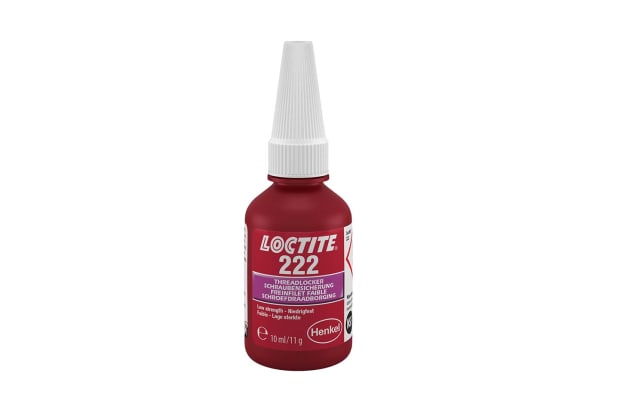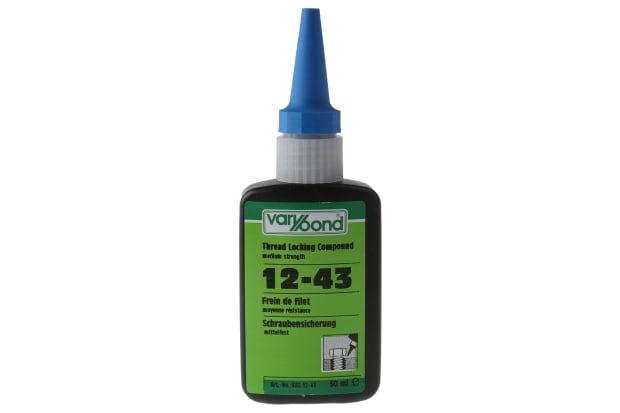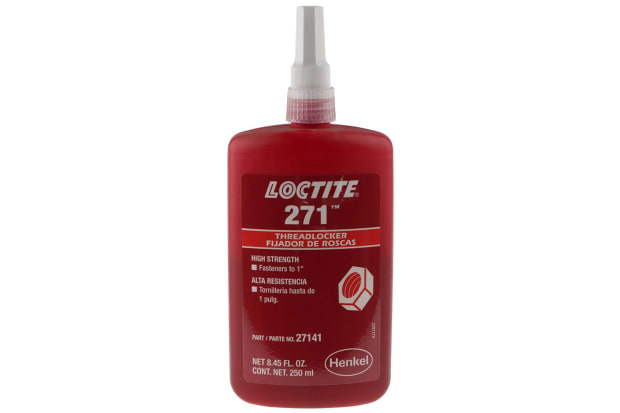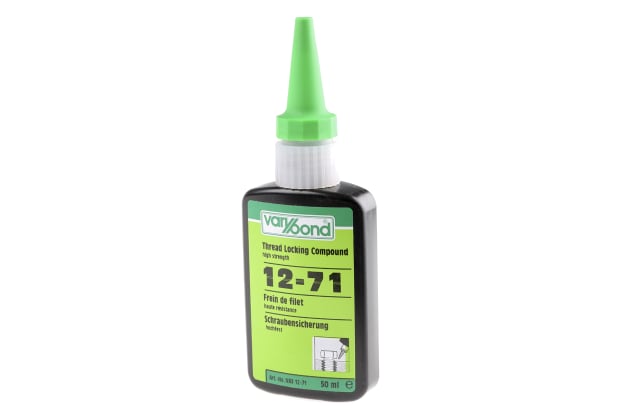- Published 30 Apr 2024
- Last Modified 30 Apr 2024
- 9 min
A Comprehensive Guide to Thread Lock
Our guide explains all the different types, strengths, and exactly what thread lock is used for.


In this comprehensive guide, we’ll take you through everything you need to know about thread lock, also known as threadlocker or thread locking glue. We’ll cover its uses, strengths, colours, and types, helping you to understand how to choose the right thread lock for your specific needs.
What is Thread Lock?

Thread lock is a type of adhesive used to secure threaded fasteners, such as screws, nuts, and bolts. Unlike traditional adhesives, thread lock is designed specifically for threaded connections. It comes in various forms, including liquids, pastes, and waxes, and can be categorised by strength, colour, and type.
Thread lock creates a strong bond between the threads of a fastener and the material it’s inserted into, preventing the fastener from loosening due to vibration, thermal expansion, or other external forces. It also provides protection against corrosion and acts as a sealant, making it a versatile solution for a wide range of applications.
In the next section, we’ll explore the different strengths of thread lock and where they are best applied.
Thread Lock Strengths
Thread lock is available in different strengths, each suited to specific applications. The three primary strengths of thread lock are low, medium, and high.
Low Strength Thread Lock
Low strength thread lock is designed for applications where you may need to remove the fasteners at a later stage. It’s typically used with small parts and provides a secure hold while still allowing for disassembly without excessive force.
Medium Strength Thread Lock
Medium strength thread lock is more robust and is commonly used in applications where you want to prevent fasteners from loosening due to vibration or other factors. It can be used with larger components and can still be removed with standard hand tools, although it may require more effort than low strength thread lock.
High Strength Thread Lock
High strength thread lock provides the most secure hold and is used in applications where you need to ensure that fasteners remain in place, even under extreme conditions. It’s commonly used with the largest fasteners and typically requires the application of heat to be removed.
In the next section, we’ll look at the different types of thread lock and their specific applications.
Types of Thread Lock
Thread lock comes in various forms, each with its own unique characteristics and best suited to different applications. The main types of thread lock include:
Thread Locking Liquids
Thread locking liquids are the most common form of thread lock. They are easy to dispense and apply, making them suitable for use with standard assemblies as well as more complex components like blind holes and fine threads.
Thread Locking Paste
Thread locking paste is typically quick-drying and can be used with a wide range of materials, including metals. It’s a popular choice for applications where a non-drip solution is required, and its ability to become brittle once fully cured makes it easier to detect any potential tampering or movement of parts.
Thread Locking Wax
Thread locking wax is often found in a tube for easy application, similar in appearance to a standard glue stick. It’s a popular choice for applications where a non-drip solution is required and is often used in outdoor or high-temperature applications. The stick format allows for more precise application and manoeuvrability.
In the next section, we’ll explore the colours of thread lock and what they indicate**.**
Thread Lock Colours
Thread lock is also categorised by colour, with different colours typically indicating different strengths or types. While not all manufacturers use the same colour code, many leading brands, including Loctite, do. Below are the most common colours and what they typically indicate.

Purple Thread Lock
Purple thread lock is typically low strength and medium viscosity. It’s a popular option thanks to the flexibility it allows, enabling easy disassembly when required.

Blue Thread Lock
Blue thread lock is medium strength and medium viscosity. Although it provides a secure hold, it is not a permanent solution, and fasteners treated with blue thread lock can still be removed using standard hand tools.

Red Thread Lock
Red thread lock is a high strength adhesive, providing a very secure hold. It is typically used in applications where you need to ensure that fasteners remain in place. It is the most permanent type of thread lock and requires the application of localised heat to loosen.

Green Thread Lock
Green thread lock is high strength and low viscosity. It can be used for wicking and is designed to provide a durable, long-lasting fastening solution.
Applications and Uses of Thread Lock
Thread lock is a versatile adhesive that finds application in a wide range of industries and scenarios. Its primary role is to secure threaded fasteners, but it offers additional benefits, such as preventing loosening due to vibration, acting as a sealant, and providing corrosion resistance.
Here are some common applications and uses of thread lock:
Industrial Machinery and Equipment
In industrial settings, thread lock is used to secure bolts, nuts, and other fasteners in heavy machinery and equipment. It helps prevent the loosening of critical components, ensuring the safety and reliability of industrial operations.
Automotive and Transportation
The automotive industry relies on thread lock to secure fasteners in vehicles, from engines to chassis components. Thread lock helps to maintain the structural integrity of automotive systems, providing safety and stability on the road.
Aerospace and Aviation
In the aerospace sector, where precision and safety are paramount, thread lock is used in the assembly and maintenance of aircraft. It ensures that fasteners remain in place under extreme conditions, contributing to the reliability of aerospace technology.
Electronics and Consumer Goods
Thread lock is used in the assembly of electronic devices and consumer goods to secure small fasteners, such as screws. It helps prevent components from coming loose due to vibration, maintaining the performance and durability of products.
Construction and Building Maintenance
In the construction industry, thread lock is employed to secure fasteners in structural components and building systems. It helps to maintain the integrity of structures and ensures that critical connections remain secure over time.
Plumbing and Pipework
Thread lock is used in plumbing and pipework installations to secure threaded connections. It helps prevent leaks by creating a reliable seal and ensures that plumbing fixtures remain tightly fastened.
In the next section, we’ll look at some additional applications of thread lock that are related to its different types and strengths.
Additional Applications of Thread Lock
In addition to the above common uses of thread lock, there are some additional applications that are related to the different strengths and types of thread lock.
Gasketing
While gasketing is often referred to under the same terms as thread lock, the two are different fastening solutions. While thread lock typically secures fasteners, gasketing is more of a form in place sealing gasket than a standard thread retainer. Gasketing is typically used in applications where a seal is required and is often used in conjunction with thread lock.
Retaining
Retaining thread lock is typically used in applications where a secure hold is required. It is designed to prevent loosening due to vibration and can also help to prevent unintentional loosening by personnel. Typical applications include bonding fitting cylindrical components.
Structural Bonding
Structural adhesive thread lock is tough and durable, providing strong adhesion to a range of different or dissimilar materials. It typically features a high shear strength and is resistant to tampering, impact, and fatigue. It is typically used in applications where a strong and secure hold is required.
Tamper Proofing
Thread lock can be used to safeguard against unwanted tampering by providing an effective sealant protecting components and assemblies. It is designed to allow any changes or movement to be spotted easily. Depending on the setting and requirements, certain types of thread lock may also prove useful when it comes to tamper-proofing.
In the next section, we’ll explore how to use thread lock and provide some tips on how to apply it effectively.
How to Use Thread Lock
Using thread lock is a straightforward process, but it’s essential to follow the manufacturer’s instructions for the specific type and form you’re using. Below, we’ll provide a general overview of how to apply thread lock effectively.
Preparation
Start by preparing the threaded fastener and the hole or surface where it will be inserted. Ensure that both the fastener and the mating surface are clean and free of any dirt, oil, or debris. You can use a degreaser or alcohol to clean the surfaces thoroughly.
Application
Apply the thread lock to the male threads of the fastener. The amount you apply will depend on the manufacturer’s recommendations, so be sure to check the product’s instructions.
For smaller fasteners, a drop or two may be sufficient, while larger fasteners may require a more generous application. Be careful not to over-apply, as excess thread lock can create a mess and may not improve the effectiveness of the seal.
Assembly
Once the thread lock is applied, assemble the fastener into the hole or onto the mating surface. Use the correct tools and torque specifications to tighten the fastener to the required level.
Curing Time
Allow the assembly to cure as per the manufacturer’s recommendations. The curing time can vary based on the type and strength of the thread lock. While some formulations may cure quickly, others may require several hours or more.
Clean-Up
After assembly, clean up any excess thread lock that may have squeezed out. Most thread lock formulations can be removed with common solvents if cleaned promptly. Be sure to follow the manufacturer's guidelines regarding the specific solvent to use for clean-up.